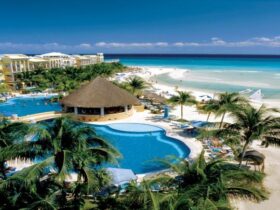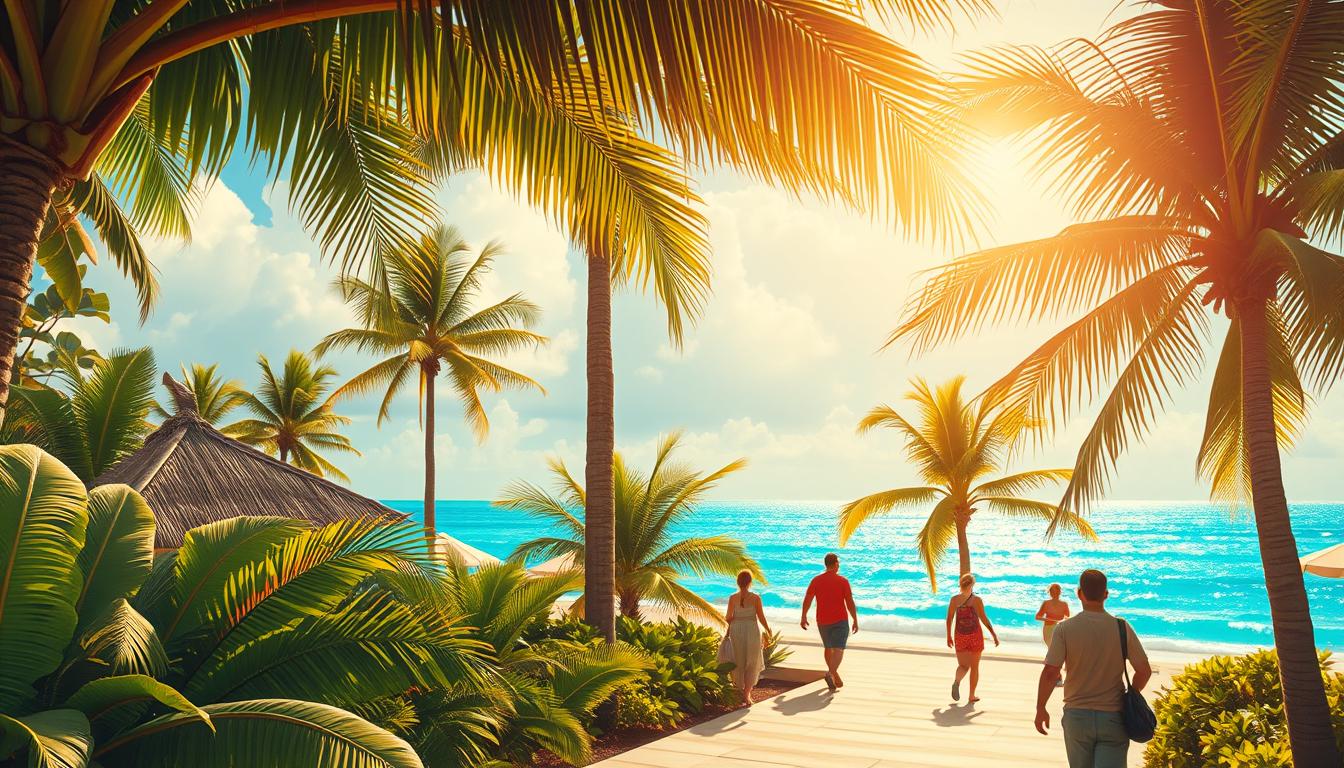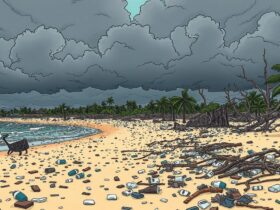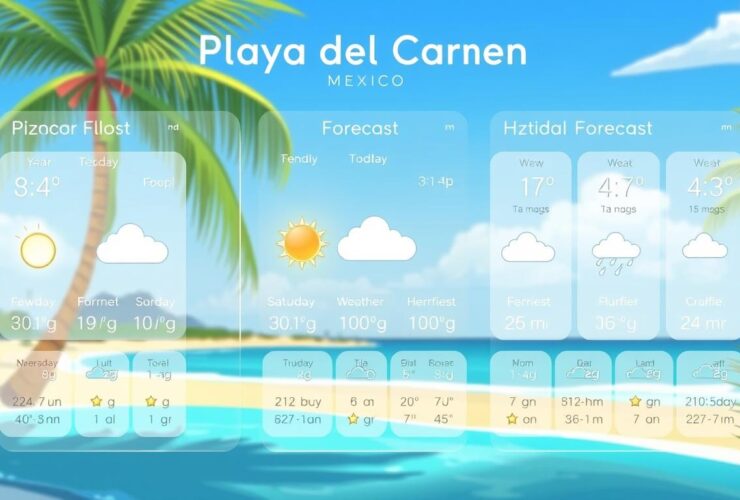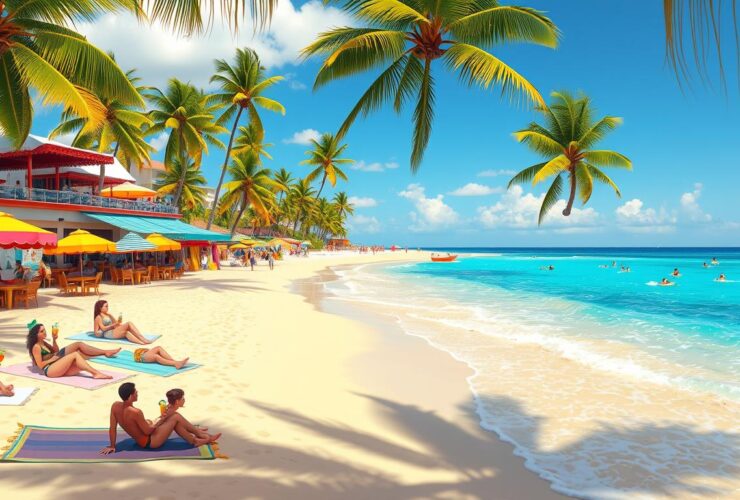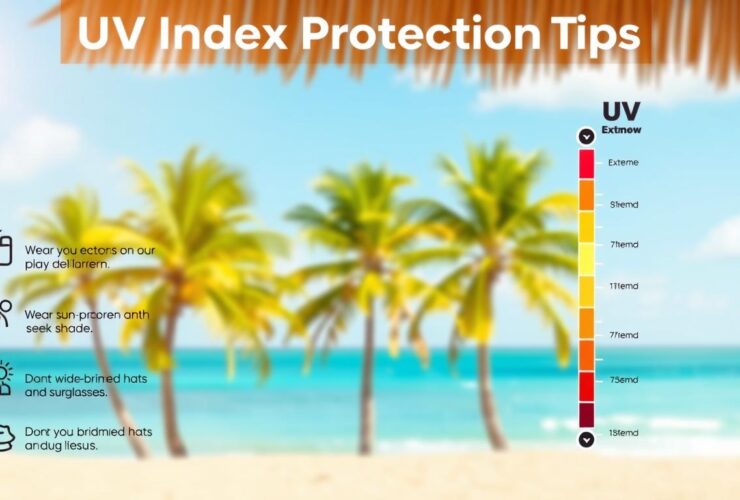Welcome to our comprehensive guide on understanding and managing humidity in Playa del Carmen, a tropical paradise that attracts visitors from around the globe. Whether you’re planning a short trip or considering a longer stay, knowing how to handle the local climate is essential for a comfortable experience.
Playa del Carmen experiences a unique climate, with long, hot, and humid summers and mild, yet still muggy, winters. Temperatures typically range from a pleasant 65°F to a sweltering 90°F throughout the year. This significant temperature variation means that understanding the local weather patterns is crucial for making the most of your time here.
Humidity can greatly affect your outdoor plans and overall comfort. By staying informed about the seasonal variations and temperature fluctuations, you can better prepare for your activities and ensure that your time in Playa del Carmen is enjoyable and stress-free.
Join our friendly and knowledgeable community as we share expert insights and practical tips on navigating the climate in Playa del Carmen. Our mission is to empower you with the local knowledge you need to make the most of your experience, whether you’re here for a visit or planning to stay longer.
Key Takeaways
- Playa del Carmen has a tropical climate with high humidity levels throughout the year.
- Temperatures range from 65°F to 90°F, with significant seasonal variations.
- Understanding local weather patterns is crucial for a comfortable travel experience.
- Humidity can impact outdoor activities and overall comfort.
- Stay informed and prepared to make the most of your time in Playa del Carmen.
Understanding Playa del Carmen Humidity Levels and Their Impact
Humidity plays a significant role in shaping daily life and travel experiences here. It’s more than just a measure of moisture in the air—it influences how the weather feels each day and throughout the year.
High humidity can make days feel oppressive, especially during outdoor activities. The muggier period lasts for 9.0 months, from March 18 to December 17, making it essential to plan accordingly.
The dew point determines comfort levels. A lower dew point means less moisture, while a higher one creates that sticky feeling. Our community offers practical advice to manage these effects, ensuring your time here remains enjoyable.
For more insights on managing comfort, explore our guide on resort amenities that can enhance your experience.
Climate Overview in Playa del Carmen
Playa del Carmen boasts a tropical wet and dry climate, characterized by distinct wet and dry seasons. The average temperature ranges from 65°F to 90°F throughout the year, with the hottest months typically falling between May and October.
Humidity is a constant companion, but the rainy season, which runs from May to October, brings the highest moisture levels. The dry season, from November to April, offers a slightly cooler and less humid environment, making it a popular time for visitors.
Here are some key points to consider:
- Average high temperature: 88°F
- Average low temperature: 70°F
- Hottest month: August (average high of 90°F)
- Coolest month: January (average low of 65°F)
Summer months are not only hot but also experience higher humidity, while winters are mild with lower humidity. This interplay between temperature and rainfall significantly impacts the overall climate comfort.
Understanding the local climate is key to making your trip enjoyable and stress-free.
The combination of temperature, rainfall, and humidity creates a unique climate profile that travelers should be aware of when planning their activities and packing.
Seasonal Temperature Variations
Understanding the temperature fluctuations in Playa del Carmen is crucial for planning your trip. The region experiences two main seasons: a hot season and a cool season, each with distinct characteristics that affect travel experiences.
The hot season, which runs from April 20 to September 16, brings high temperatures, with July being the hottest month. During this period, the average high temperature reaches 90°F, making outdoor activities by the sea and inland feel more intense. The warmth is especially noticeable in the afternoons, while early mornings and evenings offer some relief with lower temperatures.
In contrast, the cool season, from November 28 to February 13, offers a more comfortable climate. January is the coolest month, with an average low temperature of 65°F. These milder temperatures make it ideal for exploring both coastal and inland areas, providing a pleasant experience for travelers.
These temperature variations significantly impact outdoor activities. For instance, the hot season’s high temperatures might make beach days more challenging, while the cool season’s mild climate is perfect for sightseeing. Understanding these patterns helps travelers plan their activities effectively, ensuring a more enjoyable experience.
For more insights on managing comfort during your stay, explore our guide on resort amenities that can enhance your experience.
Rainfall Patterns and Precipitation Insights
Rainfall in Playa del Carmen follows a distinct pattern, with a clear division between wet and dry seasons. The wet season, lasting 5.3 months from May 25 to November 4, brings the most significant precipitation, with September being the wettest month, averaging 9.3 inches of rain. In contrast, March is the driest, with only 1.7 inches of rainfall.
Understanding these rainfall trends is crucial for planning your trip. The wet season’s heavy downpours can impact outdoor activities, while the dry season offers clearer skies and ideal conditions for exploring. With average high temperatures of 88°F, the climate remains warm year-round, but the rainfall distribution significantly influences comfort levels.
Light rain showers are common during the wet season, but heavy precipitation days are less frequent. Travelers can still enjoy their time by planning activities around the rain. For instance, scheduling outdoor tours in the morning when rainfall is typically lighter can make a big difference.
For more insights on managing your time effectively during the wet season, explore our guide on high-ROI properties, which also touches on how weather patterns can influence real estate choices.
Assessing Humidity Comfort Levels and Dew Points
Dew points are a crucial factor in determining how comfortable you feel in a tropical climate. While temperatures can fluctuate, dew points remain relatively stable, giving a clearer picture of moisture levels in the air.
A lower dew point means the air feels drier, while a higher dew point makes it feel more humid. For instance, February has the fewest muggy days, making it one of the more comfortable months. In contrast, August is the most muggy month, with high dew points that can make the air feel oppressive.
The practical impact of dew points is significant. When the dew point is high, your body’s ability to cool down through perspiration is reduced, making you feel hotter. This is why staying hydrated and wearing lightweight clothing becomes essential during these periods.
To stay comfortable, consider planning outdoor activities in the early mornings or evenings when dew points are typically lower. Additionally, choosing accommodations with air conditioning can provide much-needed relief during the hottest parts of the day.
For more insights on managing comfort, explore our guide on top all-inclusive resorts that offer amenities to enhance your experience.
Wind Conditions and Coastal Breezes
Wind conditions in Playa del Carmen play a vital role in shaping the local climate and enhancing the coastal experience. With average hourly wind speeds ranging from 5.7 mph in August to 7.6 mph in March, the region experiences a gentle breeze that moderates the temperature and adds to the comfort of visitors.
The predominant easterly winds bring a refreshing coastal breeze, especially noticeable along the beaches. This breeze not only enhances the scenic beauty but also helps mitigate the warmth during the hotter months, making outdoor activities more enjoyable for travelers planning to visit Playa del Carmen.
Seasonal variations in wind speed are notable, with March seeing the highest average wind speed of 7.6 mph, while August experiences the lowest at 5.7 mph. These variations influence the local weather patterns, with stronger winds in the spring contributing to clearer skies and drier conditions, while the summer months bring a calmer, more humid environment.
Travelers can fully enjoy the refreshing coastal breezes along the beaches, which provide natural relief from the tropical climate. Whether strolling along the shore or engaging in water activities, the consistent breeze makes the experience more pleasant. Consider planning your visit during the spring months when the breeze is strongest, offering ideal conditions for outdoor relaxation and exploration.
For those looking to make the most of their time in Playa del Carmen, understanding wind conditions can enhance their experience. Whether you’re interested in real estate opportunities or simply planning your trip, these winds contribute to the region’s allure. Explore our guide on real estate financing options to learn more about how environmental factors can influence your decisions.
Sunshine, Cloud Cover, and Daylight Hours
Sunshine and cloud cover significantly influence the travel experience in this tropical destination. Understanding these factors helps travelers plan their activities and make the most of their time here.
Clear Sky Trends Throughout the Year
The clearest skies are typically seen from November to May, with February being the clearest month. This period offers ideal conditions for outdoor activities, enhancing the overall experience. The clear skies not only boost visibility but also contribute to a brighter, more vibrant environment.
Cloud Cover Variations and Their Effects
Cloud cover varies significantly throughout the year. September is the cloudiest month, with an average cloud cover of 68%. This increased cloudiness, especially during the wet season, can make the air feel warmer due to the trapped moisture. However, these clouds often bring welcome shade and relief from direct sunlight.
| Month | Daylight Hours | Cloud Cover (%) | Clean Sky Periods |
|---|---|---|---|
| November | 12.1 | 45 | High |
| December | 12.0 | 48 | High |
| January | 11.9 | 47 | High |
| February | 11.8 | 42 | Very High |
| March | 11.9 | 44 | High |
| April | 12.2 | 46 | High |
| May | 12.3 | 48 | High |
Daylight hours range from 10.9 to 13.4 hours, providing ample time for outdoor activities. The longest daylight hours occur in May, while the shortest are in December. This variation allows travelers to plan their days effectively, ensuring they make the most of their time.
Balancing clear skies with occasional cloud cover creates an optimal environment for a memorable visit. Clear skies offer perfect conditions for photography and outdoor adventures, while clouds provide relief from the sun, making the experience more enjoyable.
Understanding these patterns helps travelers plan their activities and logistics, ensuring a fulfilling experience in this beautiful destination.
Best Time to Visit Playa del Carmen for Outdoor Activities
Planning your trip to Playa del Carmen? The ideal time for outdoor activities is from early December to mid-March, offering perfect weather for a memorable experience.
Tourism Score Insights for Optimal Weather
Tourism scores peak during this period, with late January and the last week of March being the best times for beach activities. These months offer a delightful combination of warm sunshine and gentle breezes, making every moment enjoyable.
- December to March sees average temperatures ranging from 70°F to 80°F, ideal for outdoor adventures.
- January and March have the highest beach/pool scores, ensuring perfect conditions for water activities.
Beach/Pool Score Benefits for Warm-Weather Fun
Beach and pool scores are highest from December to March, with peak scores in late January and the last week of March. These periods offer the best balance of temperature, sunshine, and wind for an unforgettable beach experience.
- December to March offers average temperatures of 70°F to 80°F, perfect for swimming and sunbathing.
- January and March have the highest beach/pool scores, making them ideal for water activities.
The combination of pleasant average temperatures, abundant sunshine, and refreshing wind creates optimal conditions for outdoor fun. Whether you’re exploring the jungle, relaxing on the beach, or snorkeling in the Caribbean, this period ensures an exceptional experience.
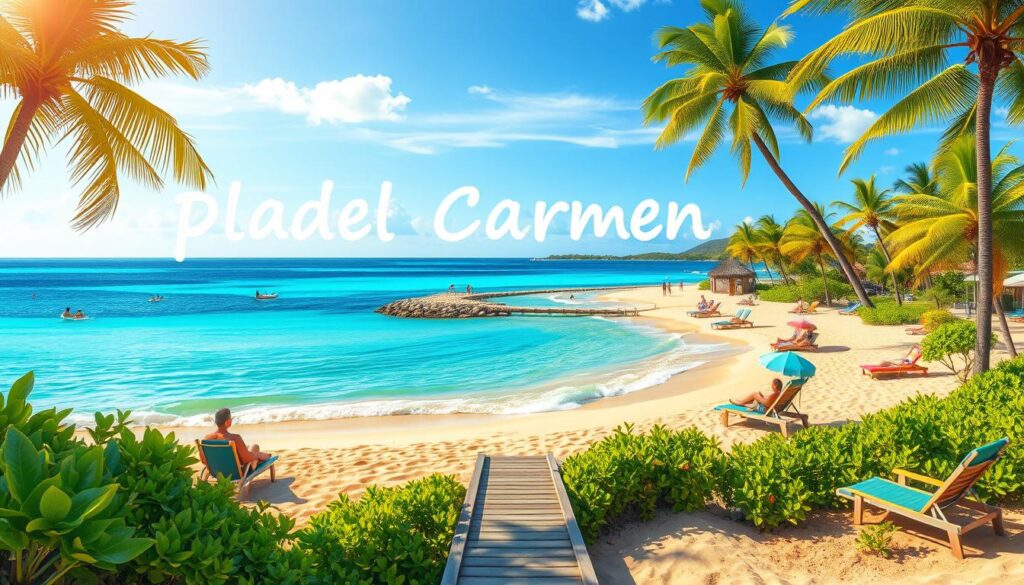
For a truly unforgettable trip, plan your visit during these ideal months. With perfect weather and numerous activities, Playa del Carmen awaits to offer you the ultimate tropical getaway.
Monthly Weather Snapshots for Travelers
Understanding the monthly weather patterns in Playa del Carmen is essential for planning your trip effectively. Whether you’re visiting during the cooler winter months or the warmer summer season, each period offers unique conditions that can enhance your travel experience.
Winter Highlights: January and February
January is the coolest month, with an average low of 65°F, making it ideal for outdoor activities. February offers mild conditions, with average temperatures ranging from 70°F to 80°F. These months feature extended daylight hours, perfect for exploring both coastal and inland areas. Precipitation is minimal, with an average of 1.7 inches in March, the driest month.
Summer Peaks: July and August
July is the hottest month, with an average high of 90°F, and August closely follows. Summer brings higher precipitation, with September being the wettest month at 9.3 inches. Despite the rain, the average high temperature remains around 88°F, ensuring warm weather year-round.
Winter’s mild climate and longer daylight hours make it perfect for activities like snorkeling and sightseeing. In contrast, summer’s warmth and rainfall create lush landscapes, ideal for nature enthusiasts. Plan your visit according to your preferences to make the most of your time here.
Practical Tips for Coping with High Humidity
Managing high humidity requires a combination of preparation and smart choices. Whether you’re here for a short visit or a longer stay, these expert tips will help you stay comfortable and make the most of your time.
Lightweight Clothing Recommendations
Dress in breathable fabrics like cotton, linen, or rayon. These materials allow air to circulate, keeping you cooler. Opt for loose-fitting clothes to reduce moisture buildup. Avoid dark colors, as they absorb heat. For added comfort, consider layering with a lightweight scarf or shawl for air-conditioned spaces.
Hydration and Cooling Strategies
Stay hydrated by drinking plenty of water throughout the day. Carry a reusable water bottle and refill it regularly. Use cooling towels or bandanas to stay cool during outdoor activities. Plan your outings for early mornings or late afternoons when the sun is less intense.
| Time of Day | Recommended Activities | Comfort Tips |
|---|---|---|
| Early Morning | Beach walks, jogging | Light, breathable clothing |
| Midday | Indoor activities, relaxation | Stay hydrated, use cooling towels |
| Late Afternoon | Swimming, sightseeing | Wear hats and sunscreen |
By following these tips, you can enjoy your time here, no matter the season. Plan ahead, dress wisely, and stay hydrated to make the most of your experience.
How Local Weather Affects Your Travel Experience
Local weather conditions play a pivotal role in shaping the mood and itinerary of any traveler. Whether it’s the warmth of the sun or the coolness of the breeze, these elements significantly influence how we experience a destination. Temperature, wind, and humidity variations can alter our plans and comfort levels, making it essential to understand and adapt to these factors.
Rapid weather changes can catch travelers off guard, affecting the pace and enjoyment of their journey. For instance, a sunny morning might suddenly turn into a rainy afternoon, disrupting outdoor plans. This unpredictability underscores the importance of flexibility in travel plans, allowing for adjustments based on weather conditions.
Knowing the best time to visit and when to plan your trip can greatly enhance your experience. Understanding seasonal trends helps travelers make informed decisions, ensuring they make the most of their time. By staying prepared with weather-specific advice, travelers can navigate their journey smartly and enjoyably.
| Time of Day | Recommended Activities | Comfort Tips |
|---|---|---|
| Early Morning | Beach walks, jogging | Light, breathable clothing |
| Midday | Indoor activities, relaxation | Stay hydrated, use cooling towels |
| Late Afternoon | Swimming, sightseeing | Wear hats and sunscreen |
By embracing flexibility and staying informed, travelers can turn weather challenges into opportunities, ensuring a memorable and enjoyable experience.
Comparing Playa del Carmen Weather to Other Tropical Destinations
When considering tropical getaways, understanding the weather is key. Let’s explore how Playa del Carmen stands out from other popular destinations.
Compared to places like Bali or Phuket, Playa del Carmen offers a more balanced climate. With average temperatures ranging from 65°F to 90°F, it avoids extreme heat, making it ideal for travelers seeking mild winters and warm summers.

While destinations such as Cancun experience higher cloud cover, Playa del Carmen enjoys clearer skies, especially from November to May, perfect for outdoor activities. This makes it a top choice for sun-seekers.
In terms of rainfall, Playa del Carmen’s dry season is drier than many tropical spots. With only 1.7 inches in March, it’s an excellent time for beach activities. In contrast, the wet season brings life to the lush surroundings, making it a nature lover’s paradise.
The best time to visit is from December to March, offering a perfect blend of warm weather and low cloud cover. This period is ideal for beach relaxation and exploring the region’s natural beauty.
For those considering real estate, Playa del Carmen’s climate is a significant advantage. Its weather patterns attract both tourists and investors. Explore our guide on Riviera Maya resorts to find your perfect retreat.
In summary, Playa del Carmen’s climate is a delightful mix of warmth and comfort, making it a standout among tropical destinations. Whether you’re here to unwind or invest, the weather enhances every experience.
Planning Your Trip Around Seasonal Weather Trends
Planning a trip to this tropical destination? Understanding the seasonal weather trends is key to making the most of your experience. By aligning your travel dates with the best weather conditions, you can ensure a memorable and enjoyable getaway.
The wet season, which runs from May to October, brings higher humidity levels and more frequent day rain. During this time, afternoon showers are common, but they often clear up by evening. If you’re planning outdoor activities, consider scheduling them in the morning when the weather is typically calmer.
The dry season, from November to April, offers cooler temperatures and lower humidity levels, making it ideal for exploring both coastal and inland areas. This period is perfect for activities like snorkeling, hiking, and sightseeing. However, it’s also the peak tourist season, so expect more crowds and higher prices.
When planning your trip, keep an eye on local weather forecasts. This will help you adjust your itinerary according to any unexpected day rain or changes in humidity levels. Staying flexible allows you to make the most of your time here, whether that means spending a rainy afternoon at a museum or enjoying a sunny morning at the beach.
For those looking to unwind in a luxurious setting, consider staying at one of the top resorts in the area. These resorts often offer amenities that cater to all kinds of weather conditions, ensuring your comfort and enjoyment throughout your stay.
Conclusion
As you plan your visit, remember that understanding the local weather is key to a seamless experience. The optimal time to explore is from December to March, with temperatures ranging from 70°F to 80°F and lower humidity levels, making it ideal for outdoor adventures.
Summer months bring higher relative humidity, especially in August, which can feel oppressive. Plan your activities around the weather month trends to avoid afternoon showers during the wet season. The chance of rain is highest in September, so scheduling outdoor plans for early mornings or late afternoons is advisable.
By considering these insights, you can navigate the climate with confidence. Stay prepared with breathable clothing, hydration, and flexible plans. Whether you’re here for a quick getaway or a longer stay, this guide equips you with the knowledge to make the most of your time.
Share these tips with fellow travelers and revisit our guide for future planning. With expert knowledge, you’re ready to embrace all that this tropical destination offers, ensuring a memorable and enjoyable experience.



